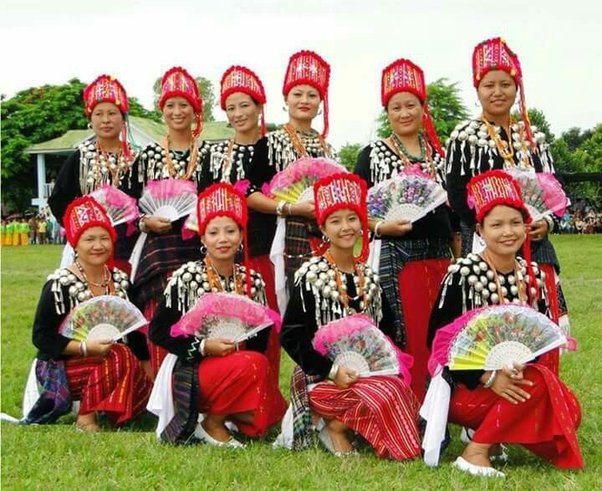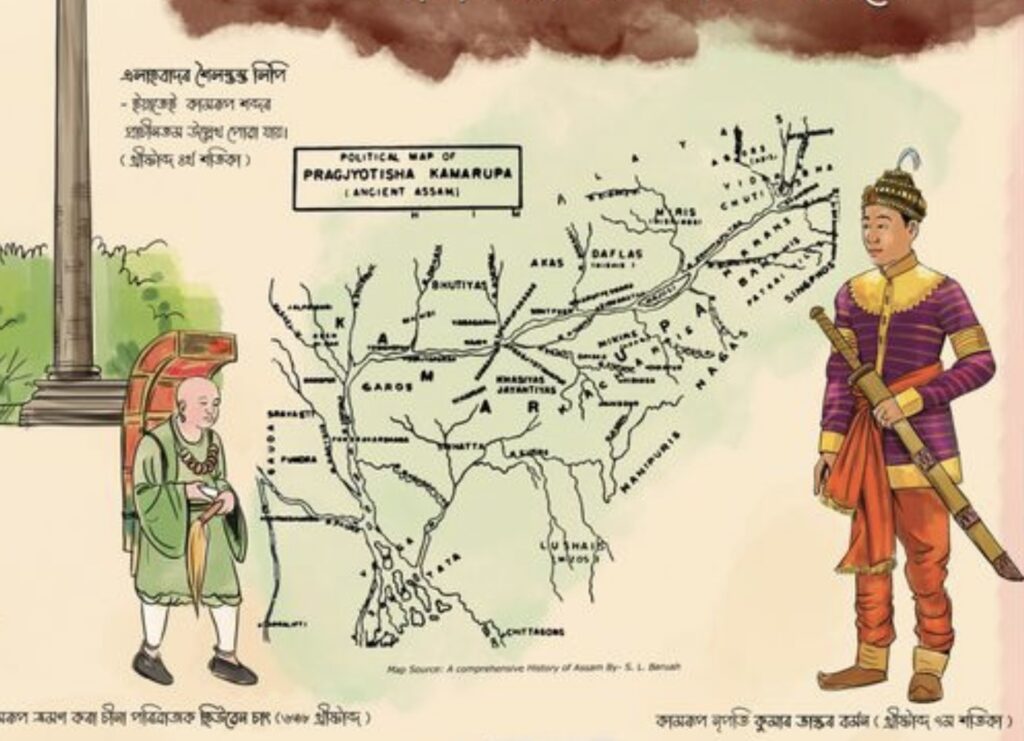Arunachal Pradesh, often referred to as the “Land of the Dawn-Lit Mountains,” is a breathtakingly beautiful state in the northeastern region of India. Nestled in the eastern Himalayas, it boasts a rich tapestry of cultures and traditions, home to numerous tribes each with its unique heritage and folklore. Among these diverse communities, the Singpho tribe stands out, renowned for its vibrant oral traditions and enchanting folktales.

Table of Contents
Arunachal Pradesh – The Folktales of the Singpho Tribe
The Singpho’s stories, passed down through generations, are a captivating blend of wisdom, humor, and moral lessons, reflecting the tribe’s deep connection to nature and their philosophical outlook on life. These narratives not only entertain but also preserve the cultural identity and values of the Singpho people, offering a window into the soul of Arunachal Pradesh.
Let’s dive into one captivating folktale from the Singphos of Arunachal Pradesh. The Singphos are known for their rich oral traditions, and their folktales often weave together elements of nature, magic, and moral lessons. Here’s a retelling of one of their enchanting stories, infused with philosophical insights.
The Tale of the Tortoise Prince from Arunachal Pradesh’s Folklore Heritage
Once upon a time, in the enchanting land of Arunachal Pradesh, there lived a very great Raja. This Raja, let’s call him Raja Ram, had a remarkable household consisting of seven wives. The Raja was rather proud of his wives, and one year, all seven became pregnant at the same time. This seemed like an omen of good fortune to Raja Ram, who already envisioned seven fine heirs to his throne.
As the months rolled by, the excitement in the palace reached a fever pitch. When the time came, the six elder wives each gave birth to human children—handsome boys with the Raja’s proud nose and their mothers’ beautiful eyes. However, the seventh and youngest wife, who was the most beautiful of all, gave birth to a tortoise. Yes, you read that right, a tortoise! This peculiar event didn’t quite fit into Raja Ram’s grand plans.
Upon seeing the tortoise baby, Raja Ram was furious. “What sort of sorcery is this?” he roared, his face turning a shade of beetroot red. Unable to fathom how a tortoise could be his offspring, he banished the seventh wife and her unusual baby to a little hut outside the village. It was a humble abode, but the seventh wife made it home, nurturing her tortoise son with love and care, despite her exile.
The Growing Boys and the Tortoise’s Desire
Years passed, and the six elder boys grew up into fine young men, each more accomplished and good-looking than the last. They were all set to embark on their first trading expedition down the river, a rite of passage for the sons of a Raja. The tortoise boy, observing his brothers’ preparations, expressed his desire to join them.
“Mother,” said the tortoise boy one evening, “my brothers are going to trade; let me go as well.”
His mother, though loving, was practical. “My dear,” she said gently, “your brothers can walk about for they have hands and feet, but you have none. What do you want to go trading for?”
The tortoise boy was undeterred. “Even if I have no hands and feet, I’d like to go,” he insisted with the stubbornness that only a teenager, human or tortoise, can muster.
Realizing she could not sway him, the mother prepared the tortoise-boy for his journey. With some deft maneuvering, she placed him in the boat alongside his six brothers. As the boat set sail down the river, the tortoise boy brought out a flute from beneath his shell and began to play.

The Magical Music and Hidden Treasures
Now, this was no ordinary flute. As the tortoise boy played, the trees along the riverbank swayed and leaned closer to listen, captivated by the enchanting melody. This is why, they say, there are so many trees along the banks of rivers even today—thanks to the tortoise boy’s magical music.
The journey downriver was smooth, and after a while, the tortoise boy asked his brothers to leave him in mid-stream. “You go on ahead,” he said. “When you return, call for me, and I will join you.”
The brothers, slightly puzzled but respectful of their sibling’s odd request, continued their journey. The tortoise boy plunged into the river and sank to the bottom. There, in the depths, he discovered a treasure trove of gold, silver, and precious stones. Cleverly, he stashed these riches beneath his shell. Further along, he found a collection of beautiful musical instruments.
When his brothers had finished their trading, they returned to the spot and called out for their tortoise brother. He emerged from the river, clambered back into the boat, and revealed the hidden treasures. He also shared the musical instruments, and together, the brothers played joyful tunes all the way home.
The Raja’s Disregard and the Tortoise’s Determination
As the boat neared their village, the Raja heard the music and assumed his sons had returned laden with wealth. He rushed to the riverbank to welcome them with honor. But, as you might have guessed, he paid no attention to the tortoise boy, leaving him at the bottom of the boat. Thankfully, his mother soon came to retrieve him.
Time passed, and the Raja decided it was time for his sons to marry. The palace buzzed with preparations. The tortoise boy, never one to miss out, approached his mother with yet another bold request.
“Mother,” he said, “my brothers are getting married; find a wife for me too.”
His mother, ever the voice of reason, was baffled. “But you are a tortoise, my dear. What sort of girl would marry you?”
The tortoise boy, with unshakeable confidence, replied, “There is a Raja’s daughter in a village not far away. I want to marry her.”
“The daughter of a Raja?” his mother exclaimed. “But you are a tortoise!”
“What does it matter?” the tortoise boy retorted. “Go and ask the girl’s father.”
The Raja’s Challenge and the Tortoise’s Triumph
Reluctantly, the mother went to the neighboring Raja and made the bold proposal. The neighboring Raja, intrigued by the audacity of the request, decided to set an impossible condition.
“Very well,” he said, with a twinkle in his eye, “I will give my daughter to your son if, within two days, before the sun rises for the second time, he brings me a boat made of gold and diamonds.”
The mother returned home, crestfallen, and relayed the message to her son. But the tortoise boy, far from being daunted, revealed the wealth he had hidden beneath his shell. He summoned a master craftsman and set him to work on creating a boat of gold and diamonds.
As dawn broke on the second day, the magnificent boat was ready. The tortoise boy, resplendent in the glittering vessel, presented it at the Raja’s palace. When the Raja came down to inspect the boat, he was greeted by the sight of the tortoise boy, who, in that moment, transformed into a handsome youth, shining like the sun itself.
The Wedding and the Philosophical Epilogue
Impressed and somewhat flabbergasted, the Raja gladly gave his daughter’s hand in marriage to the transformed tortoise boy. The wedding was a grand affair, filled with music, laughter, and more than a few bewildered looks.
Morals from the folktales from Arunachal Pradesh
Now, dear reader, what can we learn from this tale of the tortoise boy from Arunachal Pradesh? Is it simply a charming folktale, or does it hold deeper philosophical truths?
1. Embrace the Unexpected: Life often throws us curveballs, like giving birth to a tortoise instead of a human child. The trick is to adapt, accept, and find the hidden treasures in these unexpected moments.
2. Believe in Yourself: The tortoise boy never doubted his worth, even when others did. His unwavering self-belief and determination allowed him to achieve the seemingly impossible. This teaches us the power of self-confidence and perseverance.
3. See Beyond Appearances: Raja Ram’s initial rejection of his tortoise son was based on appearances. However, true value often lies beneath the surface, waiting to be discovered. This is a reminder to look beyond the exterior and recognize the potential within.
4. Music and Joy: The tortoise boy’s music brought joy and magic to those around him. This underscores the importance of creativity, art, and music in enriching our lives and connecting with others.
5. Transformation and Growth: The tortoise boy’s transformation into a handsome youth symbolizes the potential for growth and change within all of us. It’s a reminder that we are not defined by our current state but by our capacity to evolve.
6. Family and Support: Despite being banished, the seventh wife never stopped supporting her son. Her unwavering love and support were crucial to his success. This highlights the importance of family and support systems in our lives.
In the end, the story of the tortoise boy from Arunachal Pradesh is more than just a whimsical tale. It’s a rich narrative filled with humor, wisdom, and philosophical insights. So, next time you find yourself in a tricky situation, remember the tortoise boy, pull out your proverbial flute, and make some music. You never know where it might lead you—perhaps even to a boat made of gold and diamonds, or better yet, to a deeper understanding of yourself and the world around you.
Cultural Significance of the folklores
The folktales of the Singphos of Arunachal Pradesh are more than just stories; they are a means of preserving and transmitting cultural values and wisdom. The tale of Hanu and Bagha, like many other folktales, uses animal characters to convey human traits and moral lessons. These stories are often told around the fire, with family and community members gathered together, fostering a sense of unity and shared heritage.
Conclusion
The folktales of the Singphos of Arunachal Pradesh are rich with humor, wisdom, and philosophical insights. The story of the clever hare and the greedy tiger is a testament to the enduring power of wit and intelligence over brute strength and greed. As we reflect on this tale, let us remember to embrace our inner Hanu, using our minds to navigate the challenges of life with a touch of humor and a dose of wisdom. And who knows, perhaps we, too, might find ourselves outwitting the tigers that cross our paths.


